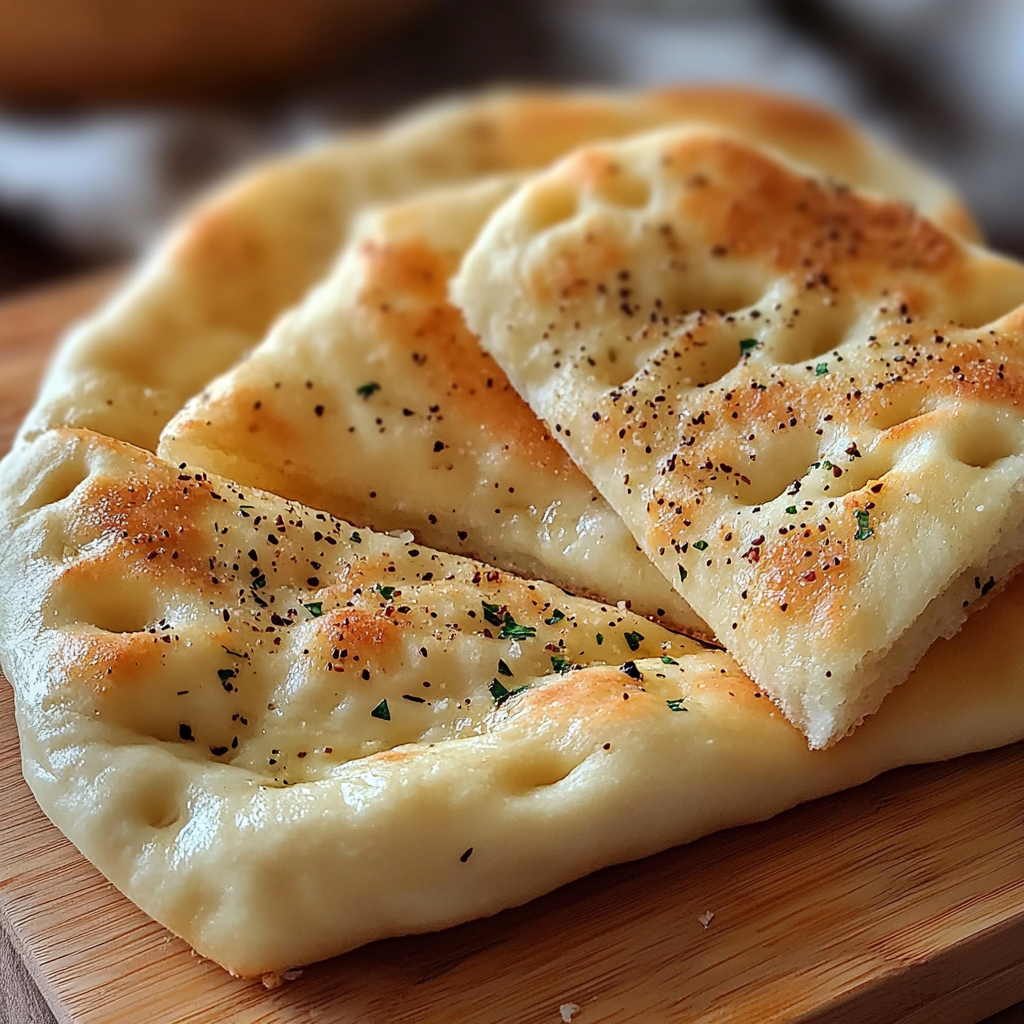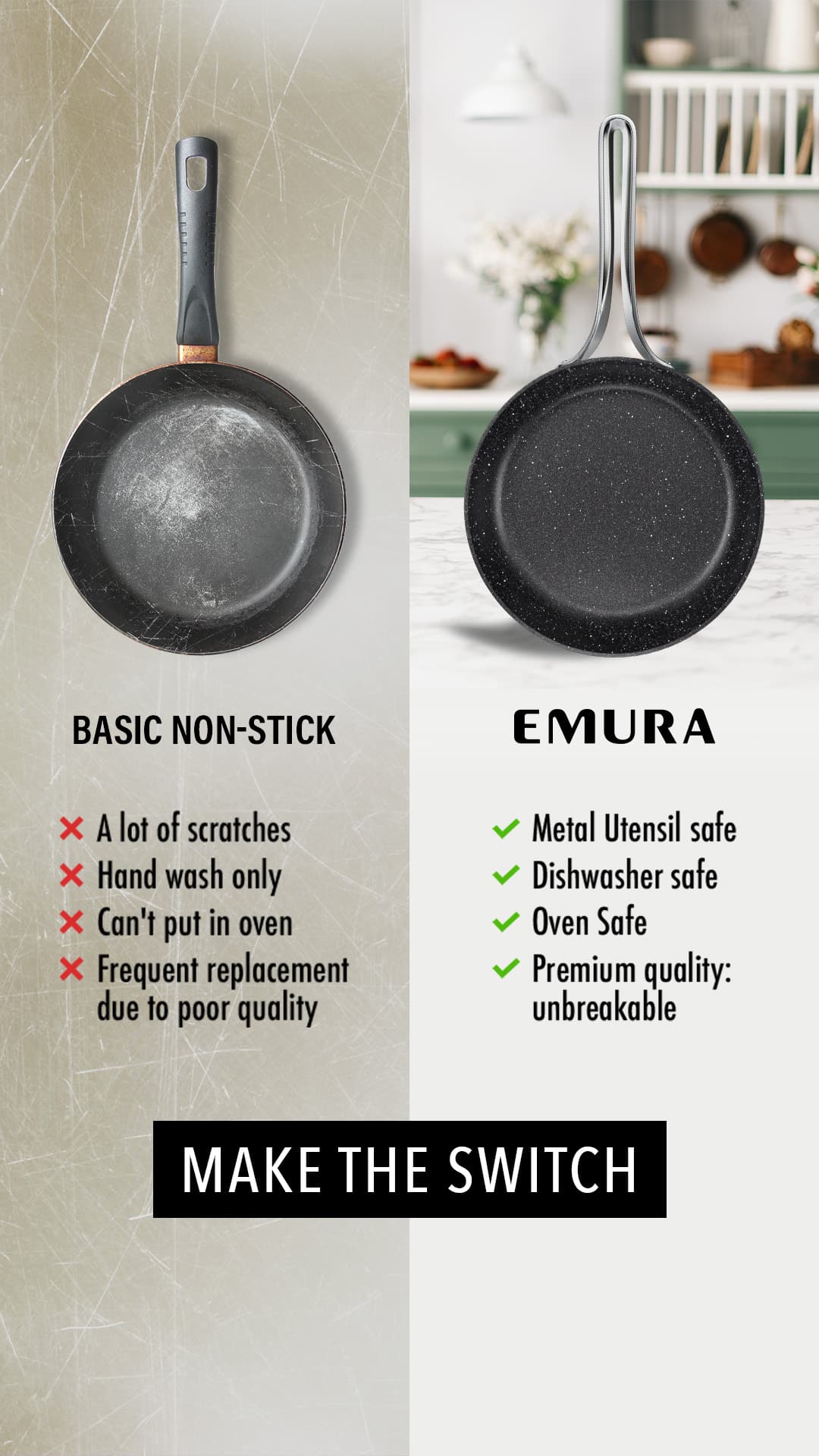No-Oven Turkish Bread, also known as Bazlama, is a wonderfully soft, slightly chewy, and fluffy flatbread that’s perfect for scooping up dips, wrapping around kebabs, or simply eating on its own. What makes this recipe even better is that you can make it with just 3 simple ingredients, and you don’t even need an oven! All you need is a stovetop and a skillet to create this delicious, authentic Turkish flatbread in no time.
Whether you’re an experienced baker or someone who is just dipping their toes into homemade bread-making, this no-oven Turkish bread is a fantastic starting point. It’s an easy, no-fuss recipe, making it perfect for those who may not have an oven, or for anyone looking to make fresh bread without the wait time associated with more complicated bread recipes. With just flour, yogurt, and baking powder, you can create soft, pillowy bread that’s versatile enough for any meal.
Let’s dive into how you can create this incredibly simple yet delicious bread in your own kitchen!
Why You’ll Love No-Oven Turkish Bread
- Super Easy: With just three ingredients, this recipe is incredibly straightforward and beginner-friendly.
- No Oven Required: All you need is a stovetop and a skillet or griddle, making it perfect for those without an oven or during hot weather when you want to avoid using the oven.
- Versatile: Turkish bread can be used as a wrap, served with dips, or enjoyed with soup. It pairs perfectly with a wide variety of dishes.
- Soft and Fluffy: The yogurt in the dough gives the bread a lovely soft texture, while the baking powder ensures a nice, airy puff.
- Quick to Make: This bread comes together in under 30 minutes, making it an excellent choice for when you need fresh bread in a hurry.
Preparation Time and Servings
- Prep time: 10 minutes
- Rest time: 10 minutes (optional)
- Cook time: 15 minutes
- Total time: 25-30 minutes
- Yield: Makes 6-8 pieces of bread
- Serving Size: 1 piece (depending on how many you make)
Nutritional Information (per serving)
- Calories: 180 kcal
- Carbs: 33g
- Protein: 6g
- Fat: 2g
- Fiber: 2g
- Sugar: 2g
(These values are approximate and will vary depending on the exact ingredients used and portion sizes.)
Ingredients
Here’s what you’ll need to make No-Oven Turkish Bread:
For the Dough:
- 2 cups all-purpose flour (plus more for dusting)
- 1 cup plain yogurt (Greek yogurt works well too)
- 1 1/2 teaspoons baking powder
Optional (but recommended):
- 1/2 teaspoon salt (for added flavor)
- 1 tablespoon olive oil (for brushing after cooking)
- Sesame seeds or nigella seeds (for sprinkling on top, optional)
Step-by-Step Instructions
Step 1: Prepare the Dough
1. Mix the Ingredients:
In a large mixing bowl, combine the all-purpose flour and baking powder. If you’re adding salt for extra flavor, mix it in at this stage. Add the plain yogurt and stir everything together until the dough starts to come together. The dough will be slightly sticky, which is normal.
2. Knead the Dough:
Transfer the dough to a floured surface and knead for about 5 minutes. You want to knead just until the dough becomes smooth and elastic. If the dough feels too sticky, sprinkle a little more flour on the surface and continue kneading. The dough should be soft, but not too wet.
3. Let the Dough Rest (Optional):
While not essential, letting the dough rest for about 10-15 minutes will make it easier to roll out and improve the texture of the bread. Simply cover the dough with a clean kitchen towel or plastic wrap and let it sit on the counter.
Step 2: Shape the Dough
1. Divide the Dough:
After the dough has rested (if you chose to rest it), divide it into 6-8 equal portions, depending on how large you want your Turkish bread. You can make larger pieces for wraps or smaller pieces for dipping or serving alongside meals.
2. Roll Out the Dough:
On a lightly floured surface, roll out each portion into a round, flat disc about 1/4 inch thick. You can use a rolling pin or press the dough out with your hands. Don’t worry about getting a perfect circle; a rustic look adds to the charm of this bread.
Step 3: Cook the Bread
1. Preheat the Skillet:
Heat a dry, non-stick skillet or griddle over medium heat. It’s important to preheat the skillet so the bread cooks evenly and puffs up nicely.
2. Cook the Bread:
Once the skillet is hot, place one piece of rolled-out dough into the skillet. Cook for 2-3 minutes on the first side until bubbles start to form on the surface, and the bottom is golden brown.
3. Flip and Cook the Other Side:
Flip the bread and cook for another 2 minutes on the other side. The bread should puff up and have nice golden-brown spots. Continue this process for all the dough portions.
Step 4: Finish and Serve the Bread
1. Optional Brushing:
Once each piece of bread is cooked, you can brush it with a little olive oil or melted butter for added flavor and softness. You can also sprinkle sesame seeds or nigella seeds on top for a traditional Turkish touch.
2. Serve Warm:
Serve the Turkish bread warm. It’s perfect for dipping into sauces, hummus, or yogurt dips, and it’s also great for wrapping around kebabs or grilled meats. You can also enjoy it as a side to soups, stews, or salads.
How to Serve No-Oven Turkish Bread
- With Dips: Serve the bread alongside dips like hummus, tzatziki, or baba ganoush for a Mediterranean-inspired appetizer or snack.
- As a Wrap: Use the bread to wrap around grilled kebabs, falafel, or shredded chicken for a hearty and delicious meal.
- With Soups or Stews: This soft, pillowy bread is perfect for dipping into soups like lentil soup, chicken stew, or turkey chili.
- As a Side Dish: Serve the bread as a side with grilled meats, salads, or roasted vegetables.
- With Breakfast: Pair the bread with scrambled eggs, cheese, and olives for a classic Turkish-style breakfast.
Additional Tips for Success
- Don’t Overwork the Dough: Knead the dough just until it comes together and is smooth. Over-kneading can make the bread tough.
- Use Yogurt for Flavor and Softness: The yogurt not only adds a tangy flavor but also keeps the bread soft and pliable. Greek yogurt works well, but you can also use regular plain yogurt.
- Preheat the Skillet: Make sure your skillet is fully preheated before cooking the bread. This ensures that the bread cooks evenly and puffs up beautifully.
- Adjust the Heat: Keep an eye on the heat while cooking the bread. If the skillet is too hot, the bread may brown too quickly on the outside without cooking through the middle. If it’s not hot enough, the bread won’t puff up as well.
- Experiment with Sizes: Feel free to make the bread as large or as small as you like. You can make smaller pieces for individual servings or larger pieces for wraps.
Recipe Variations
While this recipe is simple and perfect as is, there are plenty of ways to customize and experiment with the flavors of this No-Oven Turkish Bread. Here are a few variations to try:
1. Herbed Turkish Bread:
Add some freshly chopped parsley, cilantro, or dill to the dough for a fresh, herby flavor. You can also sprinkle herbs like oregano or thyme on top after brushing the bread with olive oil.
2. Cheese-Filled Turkish Bread:
Before rolling out each dough portion, place a small amount of shredded cheese (such as feta, mozzarella, or cheddar) in the center. Fold the dough over the cheese, then roll it out again to seal the cheese inside. This creates a delicious, melty cheese-filled flatbread.
3. Garlic Butter Turkish Bread:
For an extra burst of flavor, brush the cooked bread with a mixture of melted butter and minced garlic. This creates a rich, savory garlic bread that’s perfect for serving with pasta dishes or grilled meats.
4. Spicy Turkish Bread:
If you like a bit of heat, mix some crushed red pepper flakes or cayenne pepper into the dough for a spicy kick. Alternatively, you can sprinkle the spices on top after brushing the bread with olive oil.
5. Sweet Turkish Bread:
For a sweet version, add a teaspoon of sugar or honey to the dough, and brush the cooked bread with melted butter and a sprinkle of cinnamon sugar. This makes for a delicious snack or dessert.
Freezing and Storage
Storing Leftovers:
If you have any leftover Turkish bread, store it in an airtight container or plastic bag at room temperature for up to 2 days. To reheat, you can pop the bread in a warm skillet for a minute or two, or wrap it in foil and heat it in the oven at 300°F (150°C) until warm.
Freezing:
This bread freezes wonderfully! To freeze, allow the bread to cool completely after cooking. Then, wrap each piece individually in plastic wrap or parchment paper, and place them in a freezer-safe bag. Freeze for up to 3 months. When you’re ready to eat the bread, thaw it at room temperature and reheat it in a skillet or oven.
Reheating Tips:
For the best texture, reheat the Turkish bread in a hot skillet for a couple of minutes on each side. This helps restore the crispy exterior while keeping the inside soft. You can also reheat it in the toaster, oven, or microwave, but the texture may be slightly different.
Special Equipment
- Mixing Bowl: For combining the dough ingredients.
- Rolling Pin: To roll out the dough into flat discs.
- Non-Stick Skillet or Griddle: Essential for cooking the bread on the stovetop.
- Spatula: For flipping the bread while cooking.
Frequently Asked Questions
1. Can I use self-rising flour instead of all-purpose flour?
Yes! If you use self-rising flour, you can skip the baking powder in the recipe since self-rising flour already contains leavening agents.
2. Can I use gluten-free flour for this recipe?
Yes, you can substitute all-purpose flour with a gluten-free flour blend. Just make sure to choose a blend that includes xanthan gum or another binder to help the dough hold together.
3. Can I make the dough in advance?
Yes, you can prepare the dough ahead of time and store it in the refrigerator for up to 24 hours before cooking. Just let it come to room temperature for about 20-30 minutes before rolling it out.
4. What if I don’t have yogurt?
If you don’t have yogurt on hand, you can substitute it with buttermilk, sour cream, or even a mixture of milk and a splash of lemon juice or vinegar to create a similar tangy flavor.
5. Can I make the bread thicker or thinner?
Absolutely! If you prefer a thinner, crispier bread, roll the dough out more thinly. For a softer, thicker bread, roll the dough slightly thicker (about 1/2 inch).
Conclusion
No-Oven Turkish Bread is a simple, quick, and delicious recipe that requires just three basic ingredients: flour, yogurt, and baking powder. With its soft, chewy texture and slightly tangy flavor, this bread is perfect for pairing with dips, soups, or using as a wrap. Best of all, it’s made entirely on the stovetop, so you don’t need an oven to enjoy freshly baked bread.
Whether you’re serving this bread alongside a Mediterranean meal, using it to scoop up hummus or baba ganoush, or enjoying it as a snack with butter and jam, No-Oven Turkish Bread is a versatile recipe that’s sure to become a favorite in your kitchen.
So grab your skillet and get ready to make this easy, delicious, and crowd-pleasing bread in less than 30 minutes. Happy cooking!
Print
No-Oven Turkish Bread
- Total Time: 25-30 minutes
- Yield: Makes 6-8 pieces of bread 1x
Ingredients
For the Dough:
- 2 cups all-purpose flour (plus more for dusting)
- 1 cup plain yogurt (Greek yogurt works well too)
- 1 1/2 teaspoons baking powder
Optional (but recommended):
- 1/2 teaspoon salt (for added flavor)
- 1 tablespoon olive oil (for brushing after cooking)
- Sesame seeds or nigella seeds (for sprinkling on top, optional)
Instructions
Step 1: Prepare the Dough
1. Mix the Ingredients:
In a large mixing bowl, combine the all-purpose flour and baking powder. If you’re adding salt for extra flavor, mix it in at this stage. Add the plain yogurt and stir everything together until the dough starts to come together. The dough will be slightly sticky, which is normal.
2. Knead the Dough:
Transfer the dough to a floured surface and knead for about 5 minutes. You want to knead just until the dough becomes smooth and elastic. If the dough feels too sticky, sprinkle a little more flour on the surface and continue kneading. The dough should be soft, but not too wet.
3. Let the Dough Rest (Optional):
While not essential, letting the dough rest for about 10-15 minutes will make it easier to roll out and improve the texture of the bread. Simply cover the dough with a clean kitchen towel or plastic wrap and let it sit on the counter.
Step 2: Shape the Dough
1. Divide the Dough:
After the dough has rested (if you chose to rest it), divide it into 6-8 equal portions, depending on how large you want your Turkish bread. You can make larger pieces for wraps or smaller pieces for dipping or serving alongside meals.
2. Roll Out the Dough:
On a lightly floured surface, roll out each portion into a round, flat disc about 1/4 inch thick. You can use a rolling pin or press the dough out with your hands. Don’t worry about getting a perfect circle; a rustic look adds to the charm of this bread.
Step 3: Cook the Bread
1. Preheat the Skillet:
Heat a dry, non-stick skillet or griddle over medium heat. It’s important to preheat the skillet so the bread cooks evenly and puffs up nicely.
2. Cook the Bread:
Once the skillet is hot, place one piece of rolled-out dough into the skillet. Cook for 2-3 minutes on the first side until bubbles start to form on the surface, and the bottom is golden brown.
3. Flip and Cook the Other Side:
Flip the bread and cook for another 2 minutes on the other side. The bread should puff up and have nice golden-brown spots. Continue this process for all the dough portions.
Step 4: Finish and Serve the Bread
1. Optional Brushing:
Once each piece of bread is cooked, you can brush it with a little olive oil or melted butter for added flavor and softness. You can also sprinkle sesame seeds or nigella seeds on top for a traditional Turkish touch.
2. Serve Warm:
Serve the Turkish bread warm. It’s perfect for dipping into sauces, hummus, or yogurt dips, and it’s also great for wrapping around kebabs or grilled meats. You can also enjoy it as a side to soups, stews, or salads.
- Prep Time: 10 minutes
- Cook Time: 15 minutes
Nutrition
- Serving Size: 1 piece
- Calories: 180 kcal
- Sugar: 2g
- Fat: 2g
- Carbohydrates: 33g
- Fiber: 2g
- Protein: 6g



